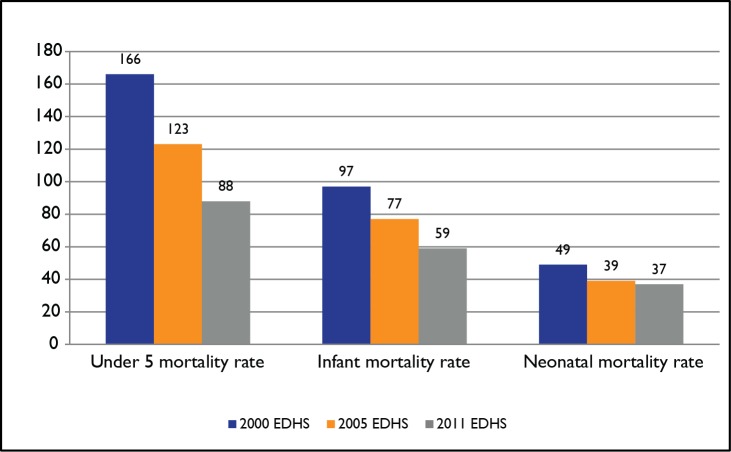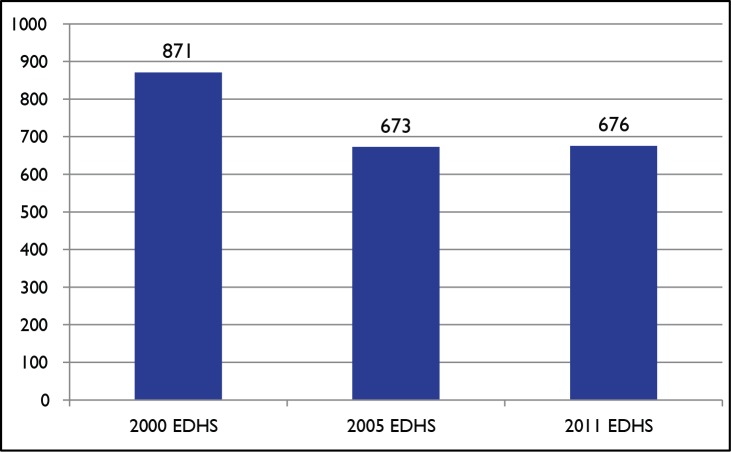Abstract
This paper is a country case study for the Universal Health Coverage Collection, organized by WHO. Abebe Alebachew and colleagues illustrate progress towards UHC and its monitoring and evaluation in Ethiopia.
Please see later in the article for the Editors' Summary
This paper is part of the PLOS Universal Health Coverage Collection. This is the summary of the Ethiopia country case study. The full paper is available as Supporting Information file Text S1.
Background
This country case study is part of the Universal Health Coverage Collection. The World Health Organization defines universal health coverage (UHC) as a situation in which all people who need health services receive them, without incurring financial hardship [1]. UHC is currently perceived as a crucial component of sustainable development and listed as one of the possible goals of the post-2015 development agenda [1]–[3].
The objectives of this paper were to document the availability of globally proposed UHC indicators [4],[5] in Ethiopia; seek feedback from selected key informants on these indicators' relevance and feasibility [6]; review the country's overall capacity to collect and use UHC indicators; and compile existing estimates for proposed UHC indicators. The paper also aimed to inform the Ethiopian government as it develops its own UHC strategy and eventually implements such policies.
Universal Health Coverage: The Policy Context
Ethiopia has not yet promulgated an official definition of UHC, although numerous strategies, policies, and guidelines are being implemented to achieve universal access to primary health care and reduce impoverishment due to health spending [7]–[13]. Existing strategies remain fragmented across health care services and financing mechanisms.
Monitoring and Evaluation for UHC
Among the 61 proposed indicators [4],[5] that were explored in this paper to measure UHC, our review indicated that 28 are collected in Ethiopia through surveys and 14 are recorded and reported through the health management information system (HMIS) or other administrative sources. Twenty-seven indicators (44%) are not collected nor reported in any of the sources [14]–[24].
Ethiopia measures most of the major service coverage indicators related to reproductive, maternal, and child health and key infectious disease services using routine information systems and population-based surveys. However, indicators of chronic, non-communicable disease service coverage are generally not available. Three indirect measures of financial coverage are available from National Health Accounts estimations, but direct measures of catastrophic spending and impoverishment due to health care spending have not been calculated.
Progress towards UHC in Ethiopia
Ethiopia has shown significant progress in reducing under-five, infant, and neonatal mortality rates over the last decade. These rates have declined by 47%, 39%, and 25%, respectively (Figure 1) [16]–[18]. According to the latest United Nations report, Ethiopia has achieved the Millennium Development Goal (MDG) goal of reducing child mortality well ahead of its 2015 deadline.
Figure 1. Trends in childhood mortality rates (deaths per 1,000 live births).
Immunization rates and the delivery of other child health services have improved substantially since 2000 [14]–[18]. However, coverage trends have been mixed for maternal and reproductive health services; the maternal mortality ratio has registered no significant change since the 2005 Demographic and Health Survey (DHS) (Figure 2) [16]–[18].
Figure 2. Trends in maternal mortality ratios (maternal deaths per 100,000 live births).
The total number of health care facilities, particularly primary care centers, has increased nearly 10-fold since 2005 and distribution on a per capita basis is largely equitable; on the other hand, secondary and tertiary level service capacity has not improved significantly [14],[15]. This shortage has been one factor leading to socioeconomic disparities in the access to and utilization of hospital level health services; other factors include costs and geographical barriers [24]. The largest improvements in service coverage between 2005 and 2011 occurred among the wealthiest households [18],[24].
Ethiopia is moving to expand financial protection through various financing initiatives. A social health insurance law was recently passed and a national health insurance agency established. Pilot community-based health insurance schemes have also been initiated. Nonetheless, out-of-pocket spending remains a major source of health financing for Ethiopia's population and is a significant barrier for accessing and utilizing health services [19]–[22].
Conclusions and Recommendations
Some of the WHO's proposed UHC measurement indicators may not yet be applicable or feasible in a low-income context like Ethiopia, particularly those requiring frequent, large population-based household surveys as well as those related to chronic conditions. Local stakeholders expressed a preference for indicators that are more programmatically relevant to their context and less resource-intensive to collect. If UHC is included in a post-MDG agenda, involving country representatives in selecting these indicators would harness political commitment towards UHC implementation.
Countries like Ethiopia should be assisted in defining and developing UHC strategies; technical support should also be given to build their capacity to collect, analyze, and use routine and survey-based information. Such capacity in Ethiopia is growing but still limited, and this has negatively impacted the quality and availability of data.
Supporting Information
The full country case study for Ethiopia.
(DOCX)
Abbreviations
- UHC
universal health coverage
Funding Statement
This work was funded by the United States Agency for International Development (USAID) through the Health Finance and Governance Project (Cooperative Agreement No. AID-OAA-A-12-00080). The funders had no role in study design, data collection and analysis, decision to publish, or preparation of the manuscript. The authors' views expressed in this publication do not necessarily reflect the views of USAID or the United States Government.
Footnotes
Provenance: Not commissioned; part of a Collection; externally peer reviewed
References
- 1.World Health Organization (2010) World health report: health systems financing: the path to universal coverage. Geneva: World Health Organization. [DOI] [PMC free article] [PubMed] [Google Scholar]
- 2.Brearly L, Marten R, O'Connell T (2013) Universal health coverage: a commitment to close the gap. New York: Rockefeller Foundation, Save the Children, the United Nations Children's Fund (UNICEF) and the World Health Organization. [Google Scholar]
- 3.Vega J (2013) Universal health coverage: the post-2015 development agenda. New York: Rockefeller Foundation. [DOI] [PubMed] [Google Scholar]
- 4.Evans D, Saksena P, Elovainio R, Boerma T (2012) Measuring progress towards universal coverage. Working paper. Geneva: World Health Organization. [Google Scholar]
- 5.World Health Organization (2012) Measurement of trends and equity in coverage of health interventions in the context of universal health coverage. Unpublished workshop summary report; September 17–21, 2012; Bellagio, Italy.
- 6.Alebachew A, Hatt L, Kukla M, Nakhimovsky S (2014) Universal health coverage measurement in a low-income context: an Ethiopian case study. Bethesda (Maryland): Health Finance & Governance Project, Abt Associates Inc. Available: http://www.hfgproject.org/wp-content/uploads/2014/04/Ethiopia_Case-Study-on-Measuring-Progress-towards-UHC_Final.pdf [Google Scholar]
- 7.Federal Ministry of Health (2013) Health sector development plan IV midterm review report. Addis Ababa: Federal Ministry of Health. [Google Scholar]
- 8.Harvard School of Public Health (2013) Rapid diagnostic study on resource tracking in Ethiopia. Boston: Harvard School of Public Health. [Google Scholar]
- 9.Federal Ministry of Health (2010) User fee revision in Ethiopia. Addis Ababa: Federal Ministry of Health. [Google Scholar]
- 10.Purvis G, Alebachew A, Wendwossen F (2011) Health Sector Financing Reform midterm project evaluation. Washington (D.C.): Global Health Technical Assistance Project. [Google Scholar]
- 11.Altman D, Alebachew A, Vogus A, Silla T, Won A (2012) Assessment of evidence-based planning in Ethiopia. Bethesda (Maryland): Health Systems 20/20 Project, Abt Associates Inc. [Google Scholar]
- 12.Federal Ministry of Health (2010) Health sector development program IV 2010/11–2014/15. Addis Ababa: Federal Ministry of Health. [Google Scholar]
- 13.Federal Ministry of Health (2010) Health insurance strategy. Addis Ababa: Federal Ministry of Health. [Google Scholar]
- 14.Federal Ministry of Health. Various. Health and health related indicator reports (EFY 2000–2013). Addis Ababa: Federal Ministry of Health. [Google Scholar]
- 15.Federal Ministry of Health. Various. Health management information system reports (EFY 2000–2013). Addis Ababa: Federal Ministry of Health. [Google Scholar]
- 16.Central Statistical Agency and ICF International (2012) Ethiopia Demographic and Health Survey 2011. Addis Ababa and Calverton (Maryland). Available: http://www.measuredhs.com/pubs/pdf/FR255/FR255.pdf
- 17.Central Statistical Agency and ORC Macro (2001) Ethiopia Demographic and Health Survey 2000. Addis Ababa and Calverton (Maryland).
- 18.Central Statistical Agency and ORC Macro (2006) Ethiopia Demographic and Health Survey 2005. Addis Ababa and Calverton (Maryland). Available: http://www.measuredhs.com/pubs/pdf/FR179/FR179%5B23June2011%5D.pdf
- 19.Federal Ministry of Health (2013) Ethiopia's fifth National Health Accounts, 2010/11. Addis Ababa: Federal Ministry of Health. [Google Scholar]
- 20.Federal Ministry of Health, Health Care Financing Team, Planning and Programming Directorate (2010) Ethiopia's fourth National Health Accounts, 2007/08. Addis Ababa: Federal Ministry of Health. Available: http://www.who.int/nha/country/eth/ethiopia_nha_4.pdf [Google Scholar]
- 21.Federal Ministry of Health, Health Care Financing Team, Planning and Programming Directorate (2006) Ethiopia's third National Health Accounts 2004/05. Bethesda (Maryland): Partners for Health Reform plus Project, Abt Associates Inc. Available: http://www.who.int/nha/country/Ethiopia-NHA3.pdf [Google Scholar]
- 22.Federal Ministry of Health, Health Care Financing Secretariat (2003) Ethiopia's second National Health Accounts 1999/2000. Addis Ababa: Federal Ministry of Health, Health Care Financing Secretariat. Available: http://www.ethiopianreview.com/pdf/001/NHA2.pdf [Google Scholar]
- 23.Central Statistics Agency (1997, 2000, 2005, 2012) Welfare Monitoring Surveys. Addis Ababa: Central Statistics Agency. [Google Scholar]
- 24.Central Statistical Agency (2011) Household income, expenditure and consumption survey. Addis Ababa: Central Statistics Agency. [Google Scholar]
Associated Data
This section collects any data citations, data availability statements, or supplementary materials included in this article.
Supplementary Materials
The full country case study for Ethiopia.
(DOCX)




